Bomb is an explosive weapon. A bomb’s explosion creates a shock wave of great pressure, also called a blast wave. The blast can damage or destroy buildings, vehicles, and living things. The explosion also typically shatters the bomb’s casing into fragments thrown out at high speeds. These deadly fragments act much like bullets. In addition, bomb explosions can cause harm and destruction through heat and fire.
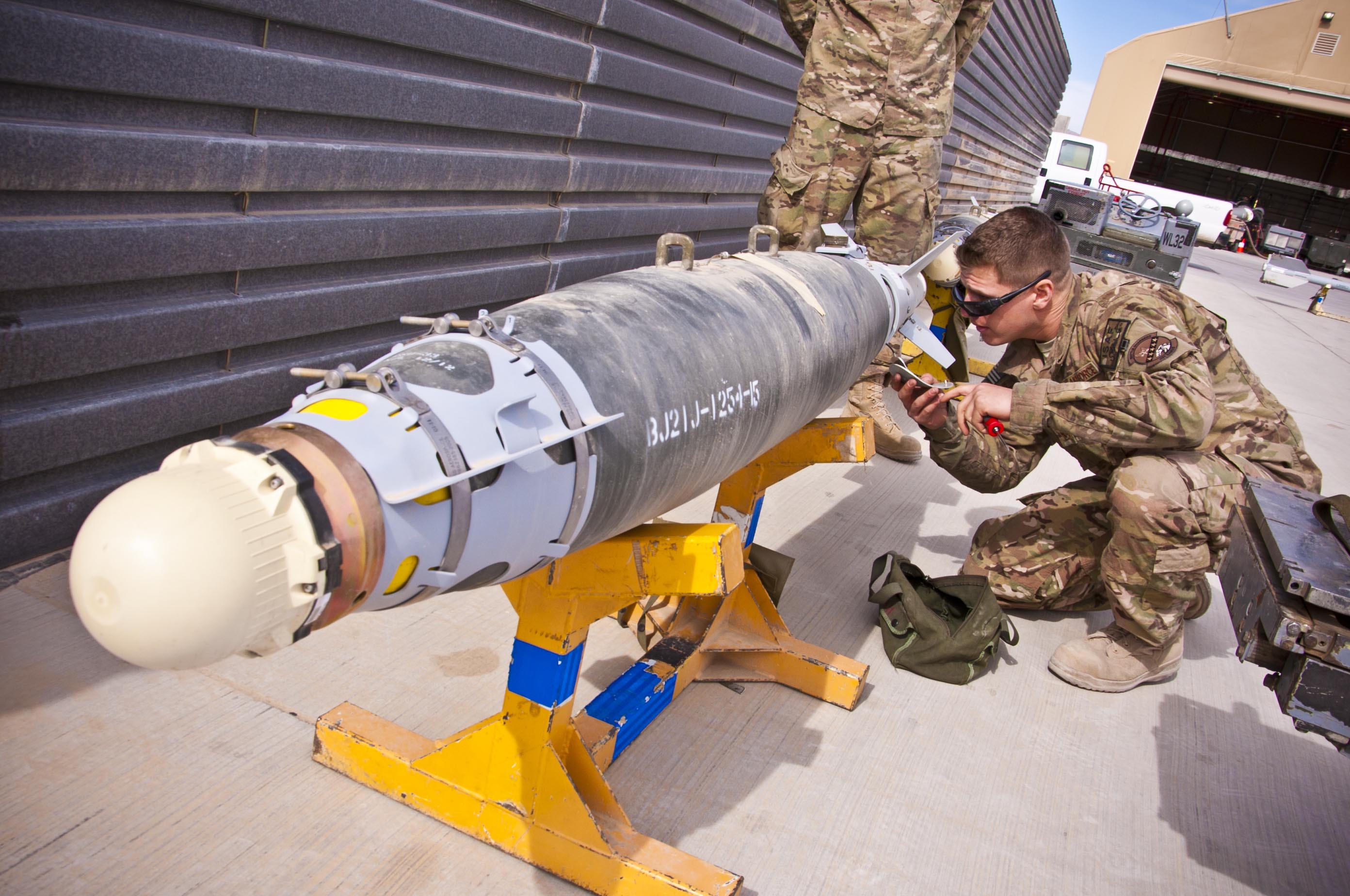
Bombs vary widely in size, materials, and method of delivery. Some bombs are small, homemade devices held in pipes, bottles, or other containers. Other bombs are precisely manufactured for use by armed forces. This article focuses on conventional (nonnuclear) bombs that are thrown, shot, or dropped from planes. For information on other explosive weapons, see the articles Guided missile , Mine warfare , and Nuclear weapon .
How bombs work
All bombs have three main components: (1) an initiating system, (2) an explosive material, and (3) a container. Some bombs are attached to delivery systems. Such systems typically use electronics to guide the bomb to its target.
The initiating system
is a fuse that sets off the bomb’s explosive material. Contact fuses trigger when a bomb strikes its target. Proximity fuses set off the bomb a short distance from the target. The distance is generally determined using radar or air pressure readings. Delay fuses can be set to explode at a certain time.
The explosive material
releases large amounts of energy when triggered. The energy released by a bomb is called its yield. Bomb yields are often expressed in terms of the weight of TNT that would produce an equally powerful blast. TNT, which stands for _t_ri_n_itro_t_oluene, is a powerful solid explosive. It can be melted and cast into various shapes.
Other explosive materials are more powerful than TNT. They include PETN (_p_enta_e_rythritol _t_etra_n_itrate) and RDX (_r_esearch _d_epartment e_x_plosive). Some bombs use a mixture of TNT and other chemicals.
Certain bombs use insensitive explosives. Such materials are specially designed to withstand unintended shocks and fires, resisting accidental explosion.
The container
holds the explosive material. When the bomb explodes, the container shatters into flying fragments that can add to the bomb’s destructiveness.
Certain bombs may have a massive container relative to their explosive material. For example, bombs designed to produce many fragments have a large container. In such bombs, the container may weigh more than twice as much as the explosive material inside. Armor- piercing bombs also typically have heavier containers, designed to ram through heavy armor.
Kinds of bombs
Bombs can be classified based on their size. Larger bombs are called munitions. Smaller bombs are called submunitions. Submunitions include hand grenades and cluster bombs. Cluster bombs consist of smaller bomblets packaged within a larger dispenser.
Loading the player...Bombing a village
Bombs can also be classified by their delivery method. Bombs that are dropped from aircraft are called gravity bombs. Some bombs are designed to strike a precise target. Others, such as cluster bombs, are designed to scatter over a wide area. Guided bombs, also called smart bombs, use electronic equipment to direct their flight. Unlike guided missiles, guided bombs are not powered by a rocket or jet engine in flight. But they can be steered as they fall with adjustable wings or fins. Some guided bombs have cameras mounted on their casings. The camera enables a remote operator to see the bomb’s target, helping to adjust its path. Other camera-equipped bombs can guide themselves. Still other bombs are guided by laser beams, by Global Positioning System (GPS) signals, or by a combination of technologies.
Finally, bombs can be classified by their effects. The following sections detail the explosive effects of several types of bombs.
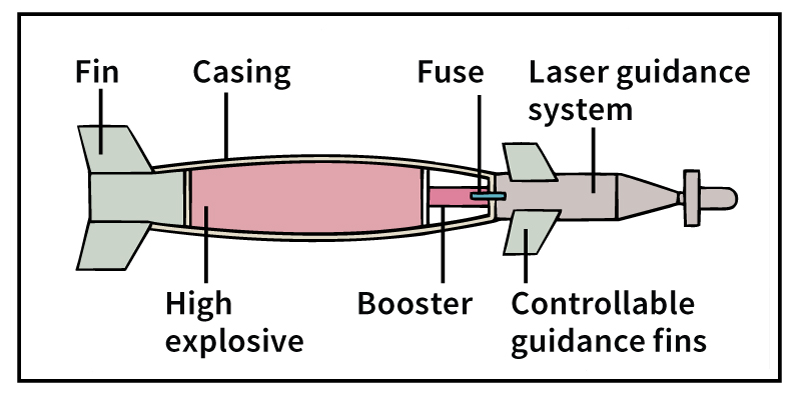
General purpose (GP) bombs
are released from an aircraft. They typically weigh from 250 to 2,000 pounds (113 to 907 kilograms). GP bombs may function as gravity bombs. They can also be attached to a guidance system, becoming guided bombs.
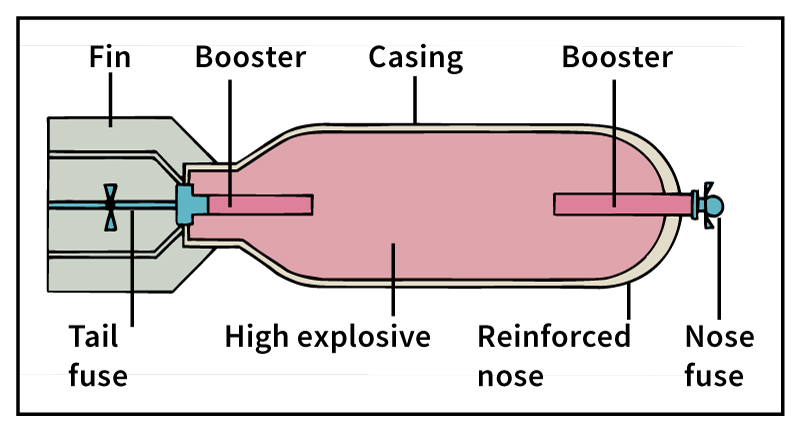
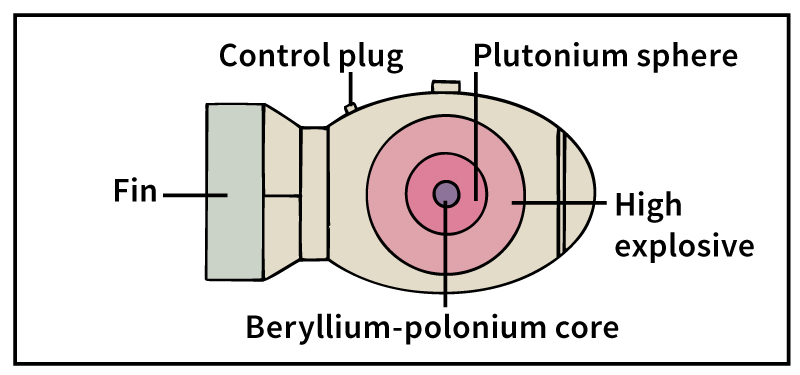
One of the largest GP bombs, known as the BLU-82B, was nicknamed the “daisy cutter.” It weighed 15,000 pounds (6,800 kilograms). Its explosive material weighed about 12,600 pounds (5,720 kilograms). The United States used the bomb in the Vietnam War (1957-1975). The bomb’s huge explosion could destroy a large area of forest and other vegetation, creating a landing zone for helicopters. The United States also used daisy cutters in the Afghanistan War (2001-2021).
In the early 2000’s, the United States developed bombs even larger than the daisy cutter. The GBU-43 massive ordnance air blast (MOAB), nicknamed the “mother of all bombs,” weighed over 20,000 pounds (9,000 kilograms). Another bomb, the GBU-57 massive ordnance penetrator (MOP), weighed about 30,000 pounds (13,600 kilograms). Such bombs can approach the destructiveness of a small nuclear weapon blast. However, they do not create deadly radioactivity, as nuclear weapons do.
Armor-piercing bombs
were developed to attack battleships and other heavily shielded targets. Such a bomb has a heavy steel nose that can penetrate thick armor or concrete. The bomb explodes inside the target.
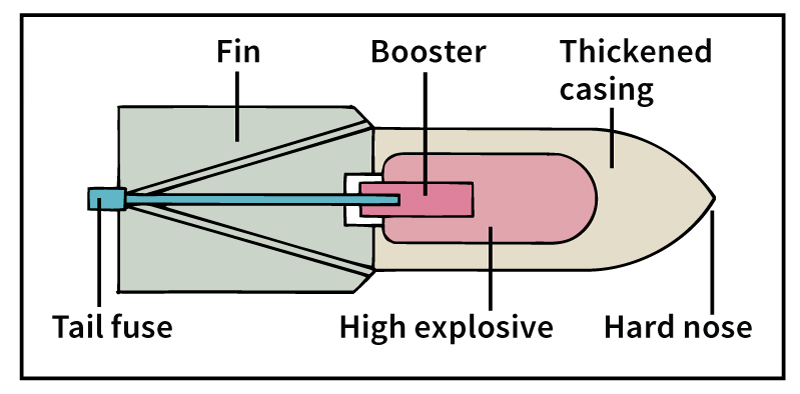
Fragmentation bombs
are designed to produce many fragments, rather than a large blast wave. They are particularly deadly against soft targets, such as lightly-armored troops in open areas. The fragments can also damage vehicles and aircraft.
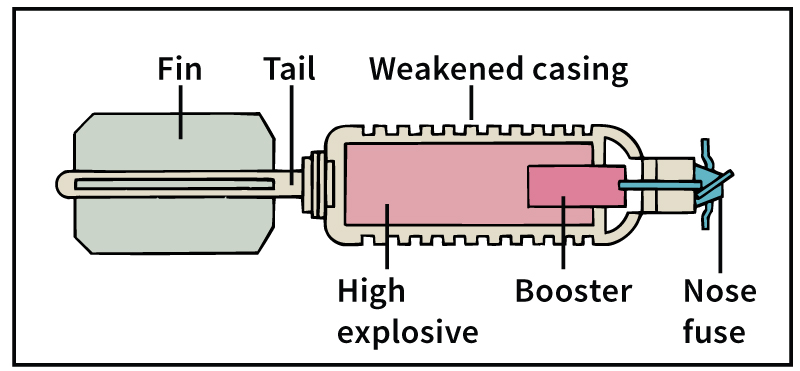
Incendiary bombs
start fires. They are often filled with gasoline compounds or thermite, a mixture of aluminum and iron oxide. The napalm bomb is a type of incendiary bomb filled with jellied gasoline. A napalm bomb’s explosion spreads a sticky gasoline mixture that immediately ignites, setting fires that are extremely difficult to put out. Another type of incendiary bomb spreads white phosphorus, which produces much toxic smoke and many deadly burns.
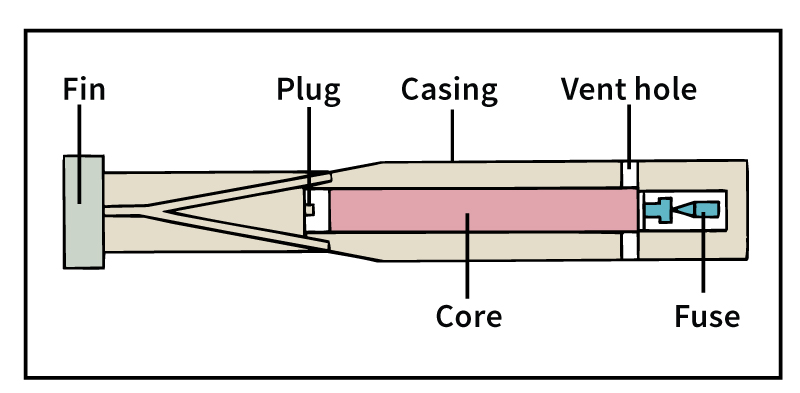
Fuel-air explosives (FAE’s)
disperse clouds of fuel that then explode in the air. They were developed by the United States during the Vietnam War to clear vegetation and destroy tunnel structures. FAE’s can be especially deadly if exploded within structures or against soft targets. In the Persian Gulf War of 1991, U.S. Marines used FAE’s to clear minefields and attack Iraqi troops in trenches.
Thermobaric explosives (TBX’s)
contain metals that increase the bomb explosion’s duration, heat output, and power. The former Soviet Union began to develop TBX’s in the 1960’s and first used the bombs in combat during the 1980’s. Since then, other countries have developed their own TBX’s. The weapons are particularly effective against soft targets and in enclosed spaces.
Other bombs
include chemical bombs, depth charges, leaflet bombs, and photoflash bombs. Chemical bombs spread smoke or poison gas. Depth charges explode underwater and are used against submarines. Leaflet bombs carry propaganda printed in the language of the enemy. The bomb blows apart in the air, scattering the leaflets over a wide area. Photoflash bombs provide light for aerial photography at night.
Dangers to civilians
Because they are often used in cities and other populated areas, bombs pose extreme dangers to civilians. During World War II (1939-1945), for example, hundreds of thousands of civilians died in bombing raids on European and Japanese cities. Guided bomb technology has made newer weapons more precise. But even the most precisely guided bomb can fall on the wrong location as a result of human error or technological failure.
Unexploded bombs, called duds, pose a unique danger to civilians. Cluster bombs, for example, often contain duds and are designed to fall over a wide area. The duds can remain dangerous to civilians years after they are dropped.
History
Austrian forces used the first aerial bombs in 1849 while trying to put down a revolt in the Italian city of Venice, which Austria then controlled. The Austrians attached bombs with slow-burning fuses to small, paper hot-air balloons. Most of the bombs missed their targets and caused little damage.
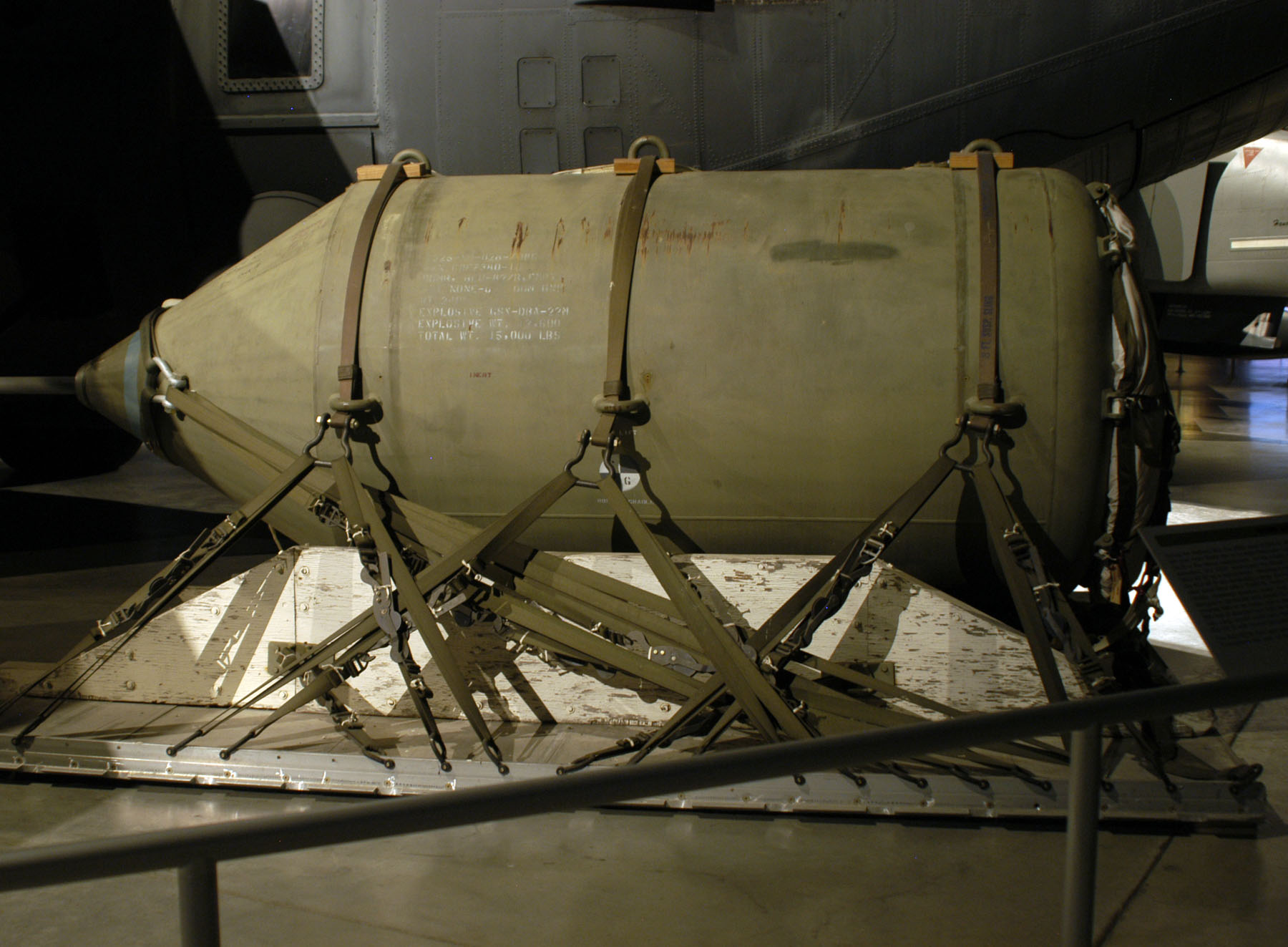
Italian forces probably dropped the first bombs from airplanes during warfare. They dropped small, grenade-like devices in a war against the Ottoman Empire in 1911. During World War I (1914-1918), American, British, French, and German planes bombed enemy positions. But the raids had little impact on the war. The early bombs were small and were dropped from planes by hand. Later bombs were larger but hard to aim accurately.
Early in World War II, the Germans made successful and highly destructive bombing raids on Rotterdam, the Netherlands; Warsaw, Poland; and other European cities. Later, the United States and the United Kingdom carried out major bombing raids on Germany and German-held areas of Europe. Germany developed the first guided bombs during the war. Some of these bombs had remotely controlled fins that responded to radio signals. The United Kingdom designed the heaviest conventional type of bomb ever used in combat—known as the “Grand Slam.” These bombs weighed about 11 tons (10 metric tons). The United States dropped over 1.5 million tons (1.4 million metric tons) of bombs on Germany during World War II. Bombing raids also were important in the war against Japan. In 1945, a massive American incendiary bombing raid on Tokyo destroyed a third of the city, killing an estimated 80,000 to 125,000 people.
During the Vietnam War, U.S. forces dropped over 6 million tons (5.4 million metric tons) of bombs on Vietnam, Laos, and Cambodia. Guided bombs were increasingly used in the Persian Gulf War of 1991, the Afghanistan War (2001-2021), and the Iraq War (2003-2011).
